 At 23:00 on 31 December 2020, the UK withdrew from the European single market. This ended the transition period which followed the UK’s departure from the EU on 31 January 2020. But, with the Trade and Cooperation Agreement (‘the deal’) signed on 30 December, it was agreed that there would be no tariffs or quotas on trade in goods between the UK and the EU.
At 23:00 on 31 December 2020, the UK withdrew from the European single market. This ended the transition period which followed the UK’s departure from the EU on 31 January 2020. But, with the Trade and Cooperation Agreement (‘the deal’) signed on 30 December, it was agreed that there would be no tariffs or quotas on trade in goods between the UK and the EU.
So what are the new economic relations between the EU and the UK and how will they impact on the UK economy? What new restrictions are there on trade in goods and on the movement of labour and capital? How is trade in services, including financial services, affected? What new agreements, such as on fishing, will replace previous agreements?
What will happen to trade between Northern Ireland and the Republic of Ireland? What will happen to trade between Great Britain and Northern Ireland?
 What will happen to regulations over standards of traded products and their production? Will the UK government be able to provide subsidies or other types of support for goods or services exported to the EU? How will disputes about standards and support to companies be resolved?
What will happen to regulations over standards of traded products and their production? Will the UK government be able to provide subsidies or other types of support for goods or services exported to the EU? How will disputes about standards and support to companies be resolved?
How will trade with non-EU countries change? If the EU has trade agreements with such countries, do these agreements now apply to trade between the UK and such countries? How free is the UK now to negotiate new trade agreements with non-EU countries? How will the UK’s negotiating strength be affected by its withdrawal from the EU?
Rather than listing the changes here, follow the links below to the articles and assess the nature of the changes and then attempt the questions. The articles represent a balance of views.
What is clear is that these are all big issues and are likely to have a significant impact on the UK economy. Most economists argue that the net effect will be negative on trade and economic growth, but there is huge uncertainty about the magnitude of the effects. Much will depend on how arrangements between the UK and the EU develop over the coming months and years.
Articles
 Brexit deal explained: What will be the impact of UK’s agreement with EU?
Brexit deal explained: What will be the impact of UK’s agreement with EU?Sky News, Ed Conway (24/12/20)
- Brexit deal: What is in it?
BBC News, Chris Morris (28/12/20)
- Brexit: What are the key points of the deal?
BBC News, Tom Edgington (30/12/20)
- Brexit trade deal explained: the key parts of the landmark agreement
Financial Times (25/12/20)
- The key details of the Brexit deal summarised, from trade to fishing
The Telegraph, James Crisp and Gordon Rayner (3/1/21)
- Committees, visas and climate change: Brexit experts’ verdicts on the deal details
The Guardian, Lisa O’Carroll (28/12/20)
- The left must stop mourning Brexit – and start seeing its huge potential
The Guardian, Larry Elliott (31/12/20)
- The Guardian view on Britain out of the EU: a treasure island for rentiers
The Guardian, Editorial (27/12/20)
- Brexit Is Finally Done, but It Already Seems Out of Date
New York Times, Mark Landler (30/12/20)
- Towards a modern UK-EU trade relationship
Best for Britain, David Henig (28/12/20)
- Brexit Is a New World Businesses Still Need to Figure Out
Bloomberg, Deirdre Hipwell, Craig Trudell, and Dara Doyle (1/1/21)
UK and EU documents
Questions
- Summarise the main features of the Trade and Cooperation Agreement and how the UK’s new relationship with the EU differs from being a member.
- What are the potential economic benefits from being outside the EU?
- What are the economic drawbacks for the UK from having left the EU, albeit with the new Trade and Cooperation Agreement?
- On balance, do you think that the UK will gain or lose economically from having left the EU? Explain your answer.
 There have been many analyses of the economic effects of Brexit, both before the referendum and at various times since, including analyses of the effects of the deal negotiated by Theresa May’s government and the EU. But with the prospect of a no-deal Brexit on 31 October under the new Boris Johnson government, attention has turned to the effects of leaving the EU without a deal.
There have been many analyses of the economic effects of Brexit, both before the referendum and at various times since, including analyses of the effects of the deal negotiated by Theresa May’s government and the EU. But with the prospect of a no-deal Brexit on 31 October under the new Boris Johnson government, attention has turned to the effects of leaving the EU without a deal.
There have been two major analyses recently of the likely effects of a no-deal Brexit – one by the International Monetary Fund (IMF) and one by the Office for Budget Responsibility (OBR).
IMF analysis
The first was in April by the IMF as part of its 6-monthly World Economic Outlook. In Scenario Box 1.1. ‘A No-Deal Brexit’ on page 28 of Chapter 1, the IMF looked at two possible scenarios.
Scenario A assumes no border disruptions and a relatively small increase in UK sovereign and corporate spreads. Scenario B incorporates significant border disruptions that increase import costs for UK firms and households (and to a lesser extent for the European Union) and a more severe tightening in financial conditions.
 Under both scenarios, UK exports to the EU and UK imports from the EU revert to WTO rules. As a result, tariffs are imposed by mid-2020 or earlier. Non-tariff barriers rise at first but are gradually reduced over time. Most free-trade arrangements between the EU and other countries are initially unavailable to the UK (see the blog EU strikes major trade deals) but both scenarios assume that ‘new trade agreements are secured after two years, and on terms similar to those currently in place.’
Under both scenarios, UK exports to the EU and UK imports from the EU revert to WTO rules. As a result, tariffs are imposed by mid-2020 or earlier. Non-tariff barriers rise at first but are gradually reduced over time. Most free-trade arrangements between the EU and other countries are initially unavailable to the UK (see the blog EU strikes major trade deals) but both scenarios assume that ‘new trade agreements are secured after two years, and on terms similar to those currently in place.’
Both scenarios also assume a reduction in net immigration from the EU of 25 000 per year until 2030. Both assume a rise in corporate and government bond rates, reflecting greater uncertainty, with the effect being greater in Scenario B. Both assume a relaxing of monetary and fiscal policy in response to downward pressures on the economy.
The IMF analysis shows a negative impact on UK GDP, with the economy falling into recession in late 2019 and in 2020. This is the result of higher trade costs and reduced business investment caused by a poorer economic outlook and increased uncertainty. By 2021, even under Scenario A, GDP is approximately 3.5% lower than it would have been if the UK had left the EU with the negotiated deal. For the rest of the EU, GDP is around 0.5% lower, although the effect varies considerably from country to country.
The IMF analysis makes optimistic assumptions, such as the UK being able to negotiate new trade deals with non-EU countries to replace those lost by leaving. More pessimistic assumptions would lead to greater costs.
OBR analysis
Building on the analysis of the IMF, the Office for Budget Responsibility considered the effect of a no-deal Brexit on the public finances in its biennial Fiscal risks report, published on 17 July 2019. This argues that, under the relatively benign Scenario A assumptions of the IMF, the lower GDP would result in annual public-sector net borrowing (PSNB) rising. By 2021/22, if the UK had left with the deal negotiated with the EU, PSNB would have been around £18bn. A no-deal Brexit would push this up to around £51bn.
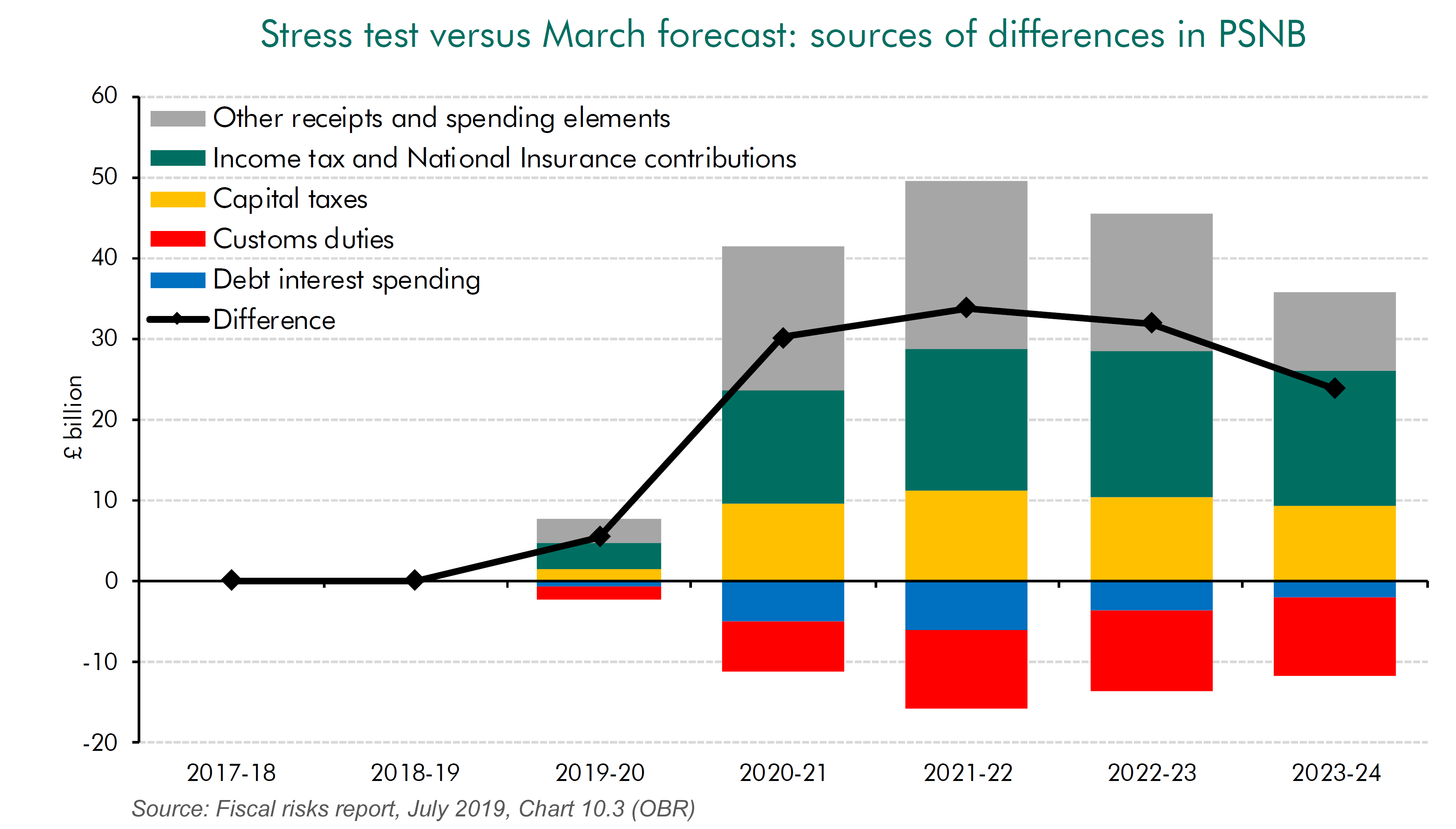
According to the OBR, the contributors to this rise in public-sector net borrowing of around £33bn are:
- A fall in income tax and national insurance receipts of around £16.5bn per year because of lower incomes.
- A fall in corporation tax and expenditure taxes, such as VAT, excise duties and stamp duty of around £22.5bn per year because of lower expenditure.
- A fall in capital taxes, such as inheritance tax and capital gains tax of around £10bn per year because of a fall in asset prices.
- These are offset to a small degree by a rise in customs duties (around £10bn) because of the imposition of tariffs and by lower debt repayments (of around £6bn) because of the Bank of England having to reduce interest rates.
The rise in PSNB would constrain the government’s ability to use fiscal policy to boost the economy and to engage in the large-scale capital projects advocated by Boris Johnson while making the substantial tax cuts he is proposing. A less optimistic set of assumptions would, of course, lead to a bigger rise in PSNB, which would further constrain fiscal policy.
Articles
Video
Reports
Questions
- What are the assumptions of the IMF World Economic Outlook forecasts for the effects of a no-deal Brexit? Do you agree with these assumptions? Explain.
- What are the assumptions of the analysis of a no-deal Brexit on the public finances in the OBR’s Fiscal risks report? Do you agree with these assumptions? Explain.
- What is the difference between forecasts and analyses of outcomes?
- For what reasons might growth over the next few years be higher than in the IMF forecasts under either scenario?
- For what reasons might growth over the next few years be lower than in the IMF forecasts under either scenario?
- For what reasons might public-sector net borrowing (PSNB) over the next few years be lower than in the OBR forecast?
- For what reasons might PSNB over the next few years be higher than in the OBR forecast?
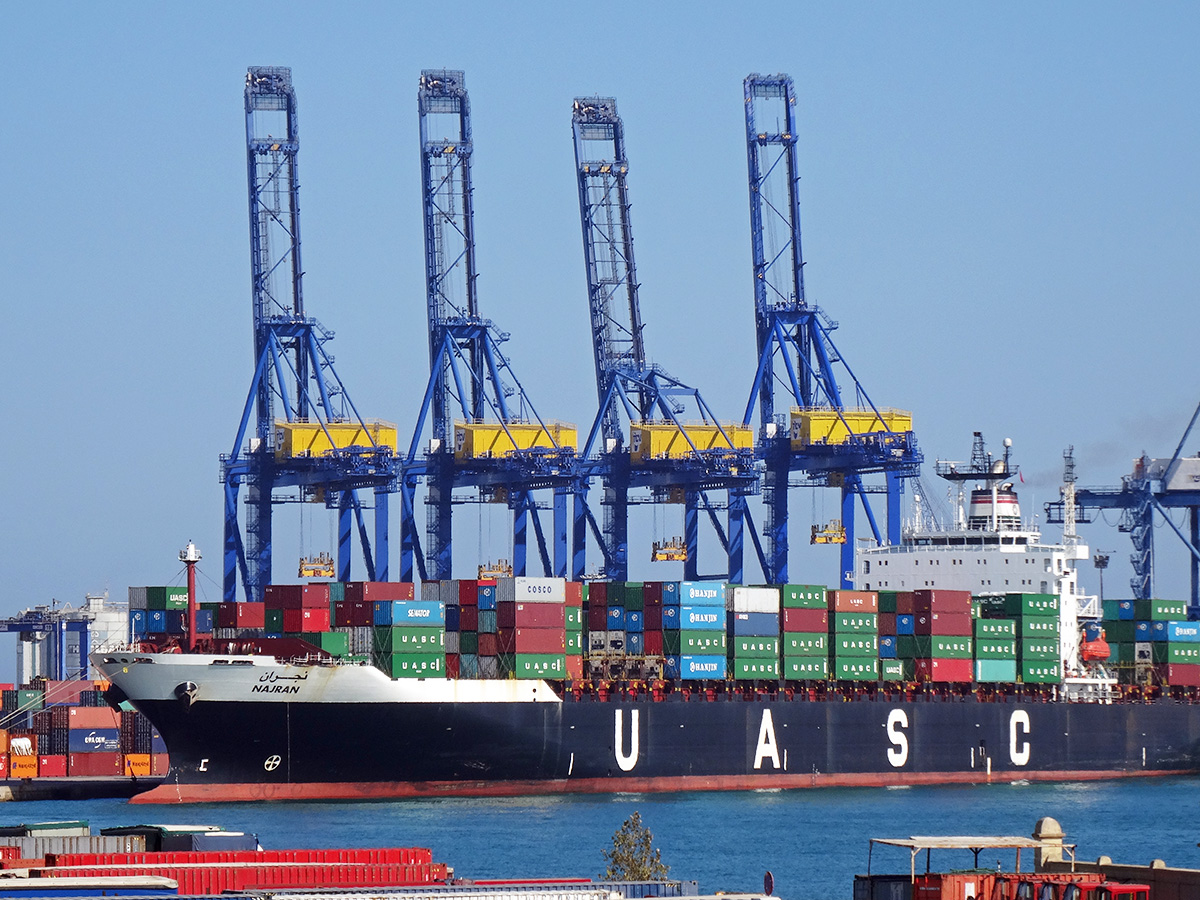 On 21st February 2019, the Department for International Trade (DIT) published a document outlining the UK’s progress in negotiating new free trade agreements (FTAs) with a number of non-EU countries. It advises UK firms that FTAs with Turkey and Japan will not be finalised before the official exit day from the European Union – 29th March 2019. Many business groups expressed concern at this news.
On 21st February 2019, the Department for International Trade (DIT) published a document outlining the UK’s progress in negotiating new free trade agreements (FTAs) with a number of non-EU countries. It advises UK firms that FTAs with Turkey and Japan will not be finalised before the official exit day from the European Union – 29th March 2019. Many business groups expressed concern at this news.
The EU has successfully negotiated a number of FTAs. These deals enable all 28 states in the European Union Custom Union (EU-CU), including the UK, to trade at preferential (i.e. lower) tariffs with over 70 non-EU countries. These include Canada, South Korea, Mexico, Israel, Norway, South Africa and Turkey. Research by the CBI estimates that UK exports to these countries were approximately £41bn in 2017 – approximately 13 per cent of all UK exports. In July 2018, the EU signed its largest ever FTA – with Japan. This deal covers 635 million people.
 If the UK leaves the European Union without a deal on the 29th March, then it immediately loses membership of the EU-CU. Preferential tariffs will no longer apply to trade between the UK and the non-EU countries which signed the FTAs. Without any new arrangements in place, tariffs and quotas will revert to the non-preferential (i.e. higher) rates outlined in registered schedules with the World Trade Organization.
If the UK leaves the European Union without a deal on the 29th March, then it immediately loses membership of the EU-CU. Preferential tariffs will no longer apply to trade between the UK and the non-EU countries which signed the FTAs. Without any new arrangements in place, tariffs and quotas will revert to the non-preferential (i.e. higher) rates outlined in registered schedules with the World Trade Organization.
Given the economic significance of this trade, the UK government has spent the past two years trying to negotiate new FTAs to replace those previously agreed by the EU. For example, on February 11th, the government announced that it had signed a ‘continuity agreement’ with Switzerland covering trade worth £32bn per year. Deals have also been finalised with Chile, Israel, and the Faroe Islands that replicate the terms of the EU agreements. However, government officials informed 30 business groups in early February that it was highly unlikely that most of the new replacement FTAs would be concluded in time for March 29th.
The document published by the DIT on the 21st February confirms this position and describes the current status of most of the new FTAs as:
Engagement ongoing
For both Japan and Turkey, the outlook is more negative. The guidance states:
We will not transition this agreement for exit day.
The head of EU negotiations at the CBI commented that:
We are really concerned that firms could be blindsided by this.
The government stated that it would significantly increase the resources devoted to the trade negotiations and expected to sign more deals over the next couple of weeks.
If the UK leaves the EU on the 29th March with a deal, then it remains in the EU-CU during the 21-month transition period. Trade will still be covered by the 40 existing EU deals. This gives UK officials until the end of December 2020 to conclude a new set of FTAs.
Articles
Government information
Questions
- Using a demand and supply diagram, illustrate the impact of tariffs on imported goods.
- The EU is perhaps the most famous example of a customs union. Find out some other examples.
- Discuss some of the potential disadvantages of free trade.
- Discuss some of the advantages and disadvantages of the UK remaining in the European Union Custom Union.
- What is a ‘registered schedule’ at the World Trade Organization?
 An agreement in principle was reached on September 30 between the USA, Canada and Mexico over a new trade deal to replace the North American Free Trade Agreement (NAFTA). President Trump had described NAFTA as ‘the worst trade deal maybe ever signed anywhere, but certainly ever signed in this country.’ The new deal, named the United States-Mexico-Canada Agreement, or USMCA, is the result of 14 months of negotiations, which have often been fractious. A provisional bilateral agreement was made between the USA and Mexico in August. At the same time, President Trump threatened a trade war with Canada if it did not reach a trade agreement with the USA (and Mexico). The new USMCA must be ratified by lawmakers in all three countries before it can come into force. This could take a few months.
An agreement in principle was reached on September 30 between the USA, Canada and Mexico over a new trade deal to replace the North American Free Trade Agreement (NAFTA). President Trump had described NAFTA as ‘the worst trade deal maybe ever signed anywhere, but certainly ever signed in this country.’ The new deal, named the United States-Mexico-Canada Agreement, or USMCA, is the result of 14 months of negotiations, which have often been fractious. A provisional bilateral agreement was made between the USA and Mexico in August. At the same time, President Trump threatened a trade war with Canada if it did not reach a trade agreement with the USA (and Mexico). The new USMCA must be ratified by lawmakers in all three countries before it can come into force. This could take a few months.
So is USMCA a radical departure from NAFTA? Does the USA stand to gain substantially, as President Trump claims? In fact, USMCA is little different from NAFTA. It could best be described as a relatively modest reworking of NAFTA. So what are the changes?
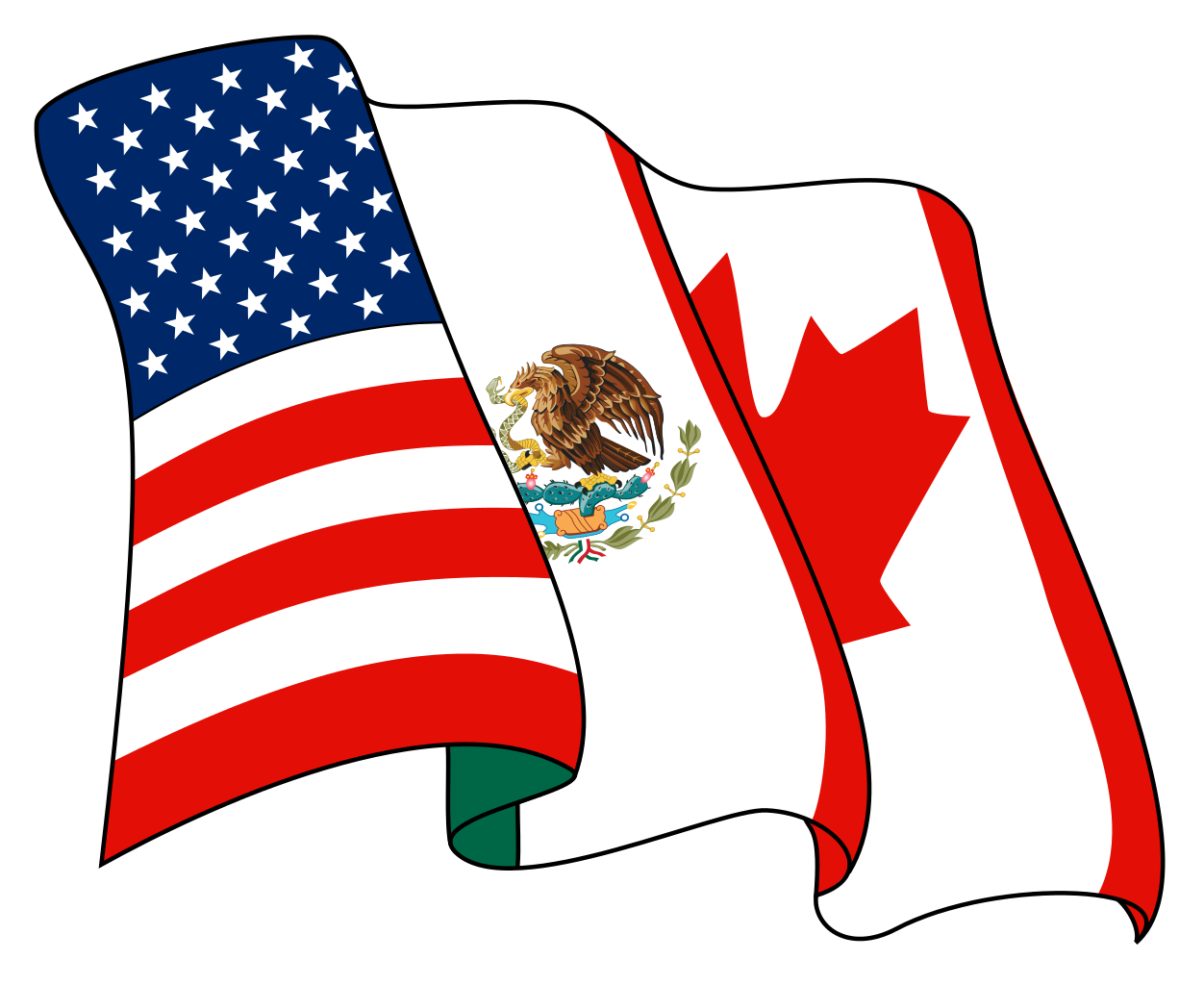 The first change affects the car industry. From 2020, 75% of the components of any vehicle crossing between the USA and Canada or Mexico must be made within one or more of the three countries to qualify for tariff-free treatment. The aim is to boost production within the region. But the main change here is merely an increase in the proportion from the current 62.5%.
The first change affects the car industry. From 2020, 75% of the components of any vehicle crossing between the USA and Canada or Mexico must be made within one or more of the three countries to qualify for tariff-free treatment. The aim is to boost production within the region. But the main change here is merely an increase in the proportion from the current 62.5%.
A more significant change affecting the car industry concerns wages. Between 40% and 45% of a vehicle’s components must be made by workers earning at least US$16 per hour. This is some three times more than the average wage currently earned by Mexican car workers. Although it will benefit such workers, it will reduce Mexico’s competitive advantage and could hence lead to some diversion of production away from Mexico. Also, it could push up the price of cars.
The agreement has also strengthened various standards inadequately covered in NAFTA. According to The Conversation article:
The new agreement includes stronger protections for patents and trademarks in areas such as biotech, financial services and domain names – all of which have advanced considerably over the past quarter century. It also contains new provisions governing the expansion of digital trade and investment in innovative products and services.
Separately, negotiators agreed to update labor and environmental standards, which were not central to the 1994 accord and are now typical in modern trade agreements. Examples include enforcing a minimum wage for autoworkers, stricter environmental standards for Mexican trucks and lots of new rules on fishing to protect marine life.
 Another area where the USMCA agreement has made changes concerns trade in dairy products. This particularly affects Canada, which has agreed to allow more US dairy products tariff-free into Canada (see the CNN article at the end of the list of articles below). New higher quotas will give US dairy farmers access to 3.6% of Canada’s dairy market. They will still pay tariffs on dairy exports to Canada that exceed the quotas, ranging from 200% to 300%.
Another area where the USMCA agreement has made changes concerns trade in dairy products. This particularly affects Canada, which has agreed to allow more US dairy products tariff-free into Canada (see the CNN article at the end of the list of articles below). New higher quotas will give US dairy farmers access to 3.6% of Canada’s dairy market. They will still pay tariffs on dairy exports to Canada that exceed the quotas, ranging from 200% to 300%.
The other significant change for consumers in Mexico and Canada is a rise in the value of duty-free imports they can bring in from the USA, including online transactions. As the first BBC article listed below states:
The new agreement raises duty-free shopping limits to $100 to enter Mexico and C$150 ($115) to enter Canada without facing import duties – well above the $50 previously allowed in Mexico and C$20 permitted by Canada. That’s good news for online shoppers in Mexico and Canada – as well as shipping firms and e-commerce companies, especially giants like Amazon.
Despite these changes, USMCA is very similar to NAFTA. It is still a preferential trade deal between the three countries, but certainly not a completely free trade deal – but nor was NAFTA.
And for the time being, US tariffs on Mexican and Canadian steel and aluminium imports remain in place. Perhaps, with the conclusion of the USMCA agreement, the Trump administration will now, as promised, consider lifting these tariffs.
Video
Articles
- USMCA, the new trade deal between the US, Canada, and Mexico, explained
Vox, Jen Kirby (2/10/18)
- USMCA: What Donald Trump’s Nafta replacement trade deal means and how it will work
Independent, Mythili Sampathkumar (2/10/18)
- USMCA trade deal: Who gets what from ‘new Nafta’?
BBC News, Jessica Murphy & Natalie Sherman (1/10/18)
- Can Trump really cut the US trade deficit?
BBC News, Andrew Walker (2/10/18)
- How is ‘new NAFTA’ different? A trade expert explains
The Conversation, Amanda M. Countryman (2/10/18)
- Was NAFTA ‘worst trade deal ever’? Few agree
PolitiFact, Jon Greenberg (29/9/18)
- NAFTA out, USMCA in: What’s in the Canada, Mexico, US trade deal?
Aljazeera, Heather Gies (2/10/18)
- Mexico boosted by US-Canada agreement on revamped Nafta deal
Financial Times, Jude Webber (3/10/18)
- Nafta Is Dead. Long Live Nafta.
Bloomberg (2/10/18)
- Trump Clears Deck for China Trade War With New Nafta Deal
Bloomberg, Rich Miller, Andrew Mayeda and Jenny Leonard (2/10/18)
- Fact check: Is Trump right that the new trade deal is “biggest” ever?
CBS News (2/10/18)
- Commentary: What Trump’s new trade pact signals about China
Reuters, Andres Martinez (4/10/18)
- Canada opened its dairy market. But by how much?
CNN, Katie Lobosco (2/10/18)
Questions
- What have been the chief gains and losses for the USA from USMCA?
- What have been the chief gains and losses for Mexico from USMCA?
- What have been the chief gains and losses for Canada from USMCA?
- What are the economic gains from free trade?
- Why might a group of countries prefer a preferential trade deal with various restrictions on trade rather than a completely free trade deal between them?
- Distinguish between trade creation and trade diversion.
- In what areas, if any, might USMCA result in trade diversion?
- If the imposition of tariffs results in a net loss from a decline in trade, why might it be in the interests of a country such as the USA to impose tariffs?
 Donald Trump has threatened to pull out of the World Trade Organization. ‘If they don’t shape up, I would withdraw from the WTO,’ he said. He argues that the USA is being treated very badly by the WTO and that the organisation needs to ‘change its ways’.
Donald Trump has threatened to pull out of the World Trade Organization. ‘If they don’t shape up, I would withdraw from the WTO,’ he said. He argues that the USA is being treated very badly by the WTO and that the organisation needs to ‘change its ways’.
Historically, the USA has done relatively well compared with other countries in trade disputes brought to the WTO. However, President Trump does not like being bound by an international organisation which prohibits the unilateral imposition of tariffs that are not in direct retaliation against a trade violation by other countries. Such tariffs have been imposed by the Trump administration on steel and aluminium imports. This has led to retaliatory tariffs on US imports by the EU, China and Canada – something that is permitted under WTO rules.
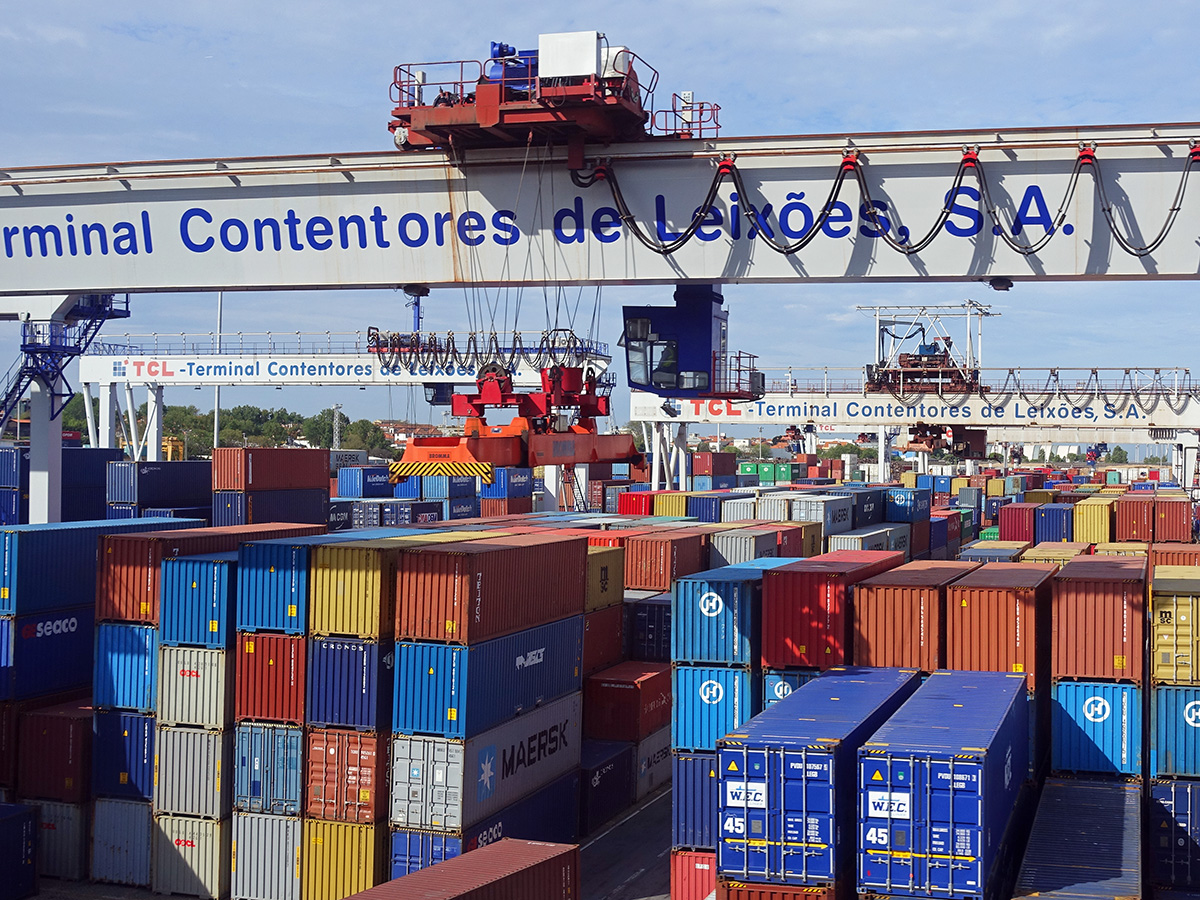 Whether or not the USA does withdraw from the WTO, Trump’s threats bring into question the power of the WTO and other countries’ compliance with WTO rules. With the rise in protectionist sentiments around the world, the power of the WTO would seem to be on the wane.
Whether or not the USA does withdraw from the WTO, Trump’s threats bring into question the power of the WTO and other countries’ compliance with WTO rules. With the rise in protectionist sentiments around the world, the power of the WTO would seem to be on the wane.
Even if the USA does not withdraw from the WTO, it is succeeding in weakening the organisation. Appeals cases have to be heard by an ‘appellate body’, consisting of at least three judges drawn from a list of seven, each elected for four years. But the USA has the power to block new appointees – and has done so. As Larry Elliott states in the first article below:
The list of judges is already down to four and will be down to the minimum of three when the Mauritian member, Shree Baboo Chekitan Servansing, retires at the end of September. Two more members will go by the end of next year, at which point the appeals process will come to a halt.
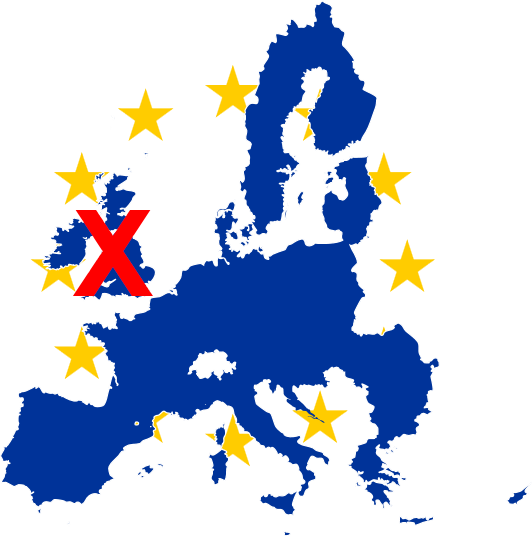 This raises the question of the implication of a ‘no-deal’ Brexit – something that seems more likely as the UK struggles to reach a trade agreement with the EU. Leaving without a deal would mean ‘reverting to WTO rules’. But if these rules are being ignored by powerful countries such as the USA and possibly China, and if the appeals procedure has ground to a halt, this could leave the UK without the safety net of international trade rules. Outside the EU – the world’s most powerful trade bloc – the UK could find itself having to accept poor trade terms with the USA and other large countries.
This raises the question of the implication of a ‘no-deal’ Brexit – something that seems more likely as the UK struggles to reach a trade agreement with the EU. Leaving without a deal would mean ‘reverting to WTO rules’. But if these rules are being ignored by powerful countries such as the USA and possibly China, and if the appeals procedure has ground to a halt, this could leave the UK without the safety net of international trade rules. Outside the EU – the world’s most powerful trade bloc – the UK could find itself having to accept poor trade terms with the USA and other large countries.
Articles
Information
Questions
- Explain the WTO’s ‘Most-favoured-nation (MFN)’ clause. How would this affect trade deals between the UK and the EU?
- Would the trade deals that the EU has negotiated with other countries, such as Japan, be available to the UK after leaving the EU?
- Demonstrate how, according to the law of comparative advantage, all countries can gain from trade.
- In what ways is the USA likely to gain and lose from the imposition of tariffs on steel and aluminium?
- How could a country that supports free trade ever support the imposition of tariffs?
- Why are tariffs not the most serious restriction on trade?
 At 23:00 on 31 December 2020, the UK withdrew from the European single market. This ended the transition period which followed the UK’s departure from the EU on 31 January 2020. But, with the Trade and Cooperation Agreement (‘the deal’) signed on 30 December, it was agreed that there would be no tariffs or quotas on trade in goods between the UK and the EU.
At 23:00 on 31 December 2020, the UK withdrew from the European single market. This ended the transition period which followed the UK’s departure from the EU on 31 January 2020. But, with the Trade and Cooperation Agreement (‘the deal’) signed on 30 December, it was agreed that there would be no tariffs or quotas on trade in goods between the UK and the EU. What will happen to regulations over standards of traded products and their production? Will the UK government be able to provide subsidies or other types of support for goods or services exported to the EU? How will disputes about standards and support to companies be resolved?
What will happen to regulations over standards of traded products and their production? Will the UK government be able to provide subsidies or other types of support for goods or services exported to the EU? How will disputes about standards and support to companies be resolved? Brexit deal explained: What will be the impact of UK’s agreement with EU?
Brexit deal explained: What will be the impact of UK’s agreement with EU? Under both scenarios, UK exports to the EU and UK imports from the EU revert to WTO rules. As a result, tariffs are imposed by mid-2020 or earlier. Non-tariff barriers rise at first but are gradually reduced over time. Most free-trade arrangements between the EU and other countries are initially unavailable to the UK (see the blog
Under both scenarios, UK exports to the EU and UK imports from the EU revert to WTO rules. As a result, tariffs are imposed by mid-2020 or earlier. Non-tariff barriers rise at first but are gradually reduced over time. Most free-trade arrangements between the EU and other countries are initially unavailable to the UK (see the blog 
 On 21st February 2019, the Department for International Trade (DIT) published a document outlining the UK’s progress in negotiating new free trade agreements (FTAs) with a number of non-EU countries. It advises UK firms that FTAs with Turkey and Japan will not be finalised before the official exit day from the European Union – 29th March 2019. Many business groups expressed concern at this news.
On 21st February 2019, the Department for International Trade (DIT) published a document outlining the UK’s progress in negotiating new free trade agreements (FTAs) with a number of non-EU countries. It advises UK firms that FTAs with Turkey and Japan will not be finalised before the official exit day from the European Union – 29th March 2019. Many business groups expressed concern at this news. An agreement in principle was reached on September 30 between the USA, Canada and Mexico over a new trade deal to replace the North American Free Trade Agreement (NAFTA). President Trump had described NAFTA as ‘the worst trade deal maybe ever signed anywhere, but certainly ever signed in this country.’ The new deal, named the United States-Mexico-Canada Agreement, or USMCA, is the result of 14 months of negotiations, which have often been fractious. A provisional bilateral agreement was made
An agreement in principle was reached on September 30 between the USA, Canada and Mexico over a new trade deal to replace the North American Free Trade Agreement (NAFTA). President Trump had described NAFTA as ‘the worst trade deal maybe ever signed anywhere, but certainly ever signed in this country.’ The new deal, named the United States-Mexico-Canada Agreement, or USMCA, is the result of 14 months of negotiations, which have often been fractious. A provisional bilateral agreement was made  The first change affects the car industry. From 2020, 75% of the components of any vehicle crossing between the USA and Canada or Mexico must be made within one or more of the three countries to qualify for tariff-free treatment. The aim is to boost production within the region. But the main change here is merely an increase in the proportion from the current 62.5%.
The first change affects the car industry. From 2020, 75% of the components of any vehicle crossing between the USA and Canada or Mexico must be made within one or more of the three countries to qualify for tariff-free treatment. The aim is to boost production within the region. But the main change here is merely an increase in the proportion from the current 62.5%. Another area where the USMCA agreement has made changes concerns trade in dairy products. This particularly affects Canada, which has agreed to allow more US dairy products tariff-free into Canada (see the CNN article at the end of the list of articles below). New higher quotas will give US dairy farmers access to 3.6% of Canada’s dairy market. They will still pay tariffs on dairy exports to Canada that exceed the quotas, ranging from 200% to 300%.
Another area where the USMCA agreement has made changes concerns trade in dairy products. This particularly affects Canada, which has agreed to allow more US dairy products tariff-free into Canada (see the CNN article at the end of the list of articles below). New higher quotas will give US dairy farmers access to 3.6% of Canada’s dairy market. They will still pay tariffs on dairy exports to Canada that exceed the quotas, ranging from 200% to 300%. Whether or not the USA does withdraw from the WTO, Trump’s threats bring into question the power of the WTO and other countries’ compliance with WTO rules. With the rise in protectionist sentiments around the world, the power of the WTO would seem to be on the wane.
Whether or not the USA does withdraw from the WTO, Trump’s threats bring into question the power of the WTO and other countries’ compliance with WTO rules. With the rise in protectionist sentiments around the world, the power of the WTO would seem to be on the wane. This raises the question of the implication of a ‘no-deal’ Brexit – something that seems more likely as the UK struggles to reach a trade agreement with the EU. Leaving without a deal would mean ‘reverting to WTO rules’. But if these rules are being ignored by powerful countries such as the USA and possibly China, and if the appeals procedure has ground to a halt, this could leave the UK without the safety net of international trade rules. Outside the EU – the world’s most powerful trade bloc – the UK could find itself having to accept poor trade terms with the USA and other large countries.
This raises the question of the implication of a ‘no-deal’ Brexit – something that seems more likely as the UK struggles to reach a trade agreement with the EU. Leaving without a deal would mean ‘reverting to WTO rules’. But if these rules are being ignored by powerful countries such as the USA and possibly China, and if the appeals procedure has ground to a halt, this could leave the UK without the safety net of international trade rules. Outside the EU – the world’s most powerful trade bloc – the UK could find itself having to accept poor trade terms with the USA and other large countries.